Overview:
Costa Rica is located in Central America, between Nicaragua and Panama. The Caribbean Sea and the Pacific Ocean are located on either side of the country. Costa Rica has several different ecosystems including: Central American dry forest, Southern Mesoamerican Pacific mangroves, Mesoamerican Gulf-Caribbean mangroves, Costa Rican seasonal moist forest, Talamancan montane forest, Isthmian-Atlantic moist forest, Isthmian-Pacific moist forest and Cocos Island moist forest (1). We will be focusing on Isthmian-Atlantic and Isthmian-Pacific moist forest, which is also known as the tropical rainforest of Costa Rica. The tropical rainforest are located in lowland slopes of 500m or less, which can be seen in the northern, Caribbean, central and southern Pacific lowlands of Costa Rica (2). The forest can be characterized as a broad leaf forest, and year round precipitation with warm temperatures.

Here is a map of Costa Rica, with the dark green showing where the Tropical Rainforest are located.
Source: http://www.costarica21.com/Tropical-Rainforest.html
Source: http://www.costarica21.com/Tropical-Rainforest.html
Past:
Tropical rainforest are the survivors of the prehistoric jungles of our past (3). Humans have lived in the rainforest of Costa Rica for 10,000 years (4). These forests were discontinuous, volcanically active, and topographically and environmentally diverse. They were lush, tall evergreen forest, with huge canopy trees, and extremely rich in epiphyte flora and lianas (5).
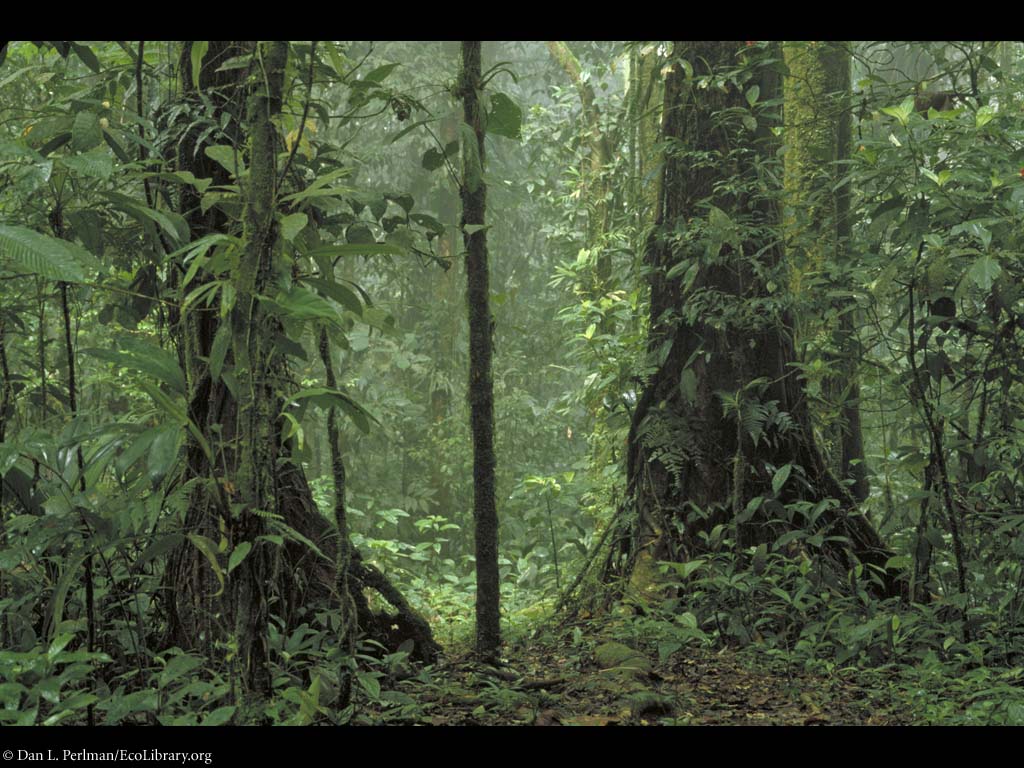
Source: http://ecolibrary.org/images/full_image/Tropical_rainforest_Costa_Rica_DP25.jpg

Source: https://blogger.googleusercontent.com/img/b/R29vZ2xl/AVvXsEh1mWmDCAIcgVACXiZCTW7Eum8hXUHhje7nrH2X3bO6zdfyPq9kyqKudPoJsTRsrVapAgRjde8-iuWn6onO1takICm32f3x4qhQz0rytpkP-s0pnHpoKni2gbMDDFxr00-mPw4Pa5v8tKs/s1600/Monteverde+Rainforest,+Costa+Rica.jpg

Source: http://farm2.staticflickr.com/1346/663194594_94efc2f9a9_o.jpg
In the early 1970s, Costa Rica was experiencing intensive deforestation for agriculture and cattle raising. This in return led to land settlements, the new construction of highways, and trade in wild animal life products (6). Deforestation caused lots of endangerment to different species in the rainforest, some which include, the Great Green Macaw, Sloths, sea turtles, jaguars, marmosets, and lion tamarins (7,8).
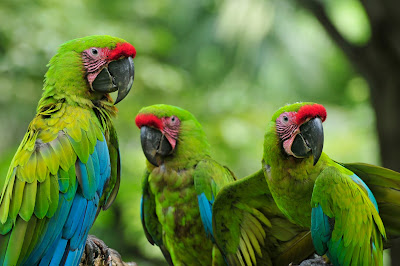
Great Green Macaw
Source: http://4.bp.blogspot.com/-OlLhuvUFsLA/Tr52pvKfOaI/AAAAAAAAAR4/RMjlq4MK2X0/s1600/Great+Green+Macaw+1.jpg
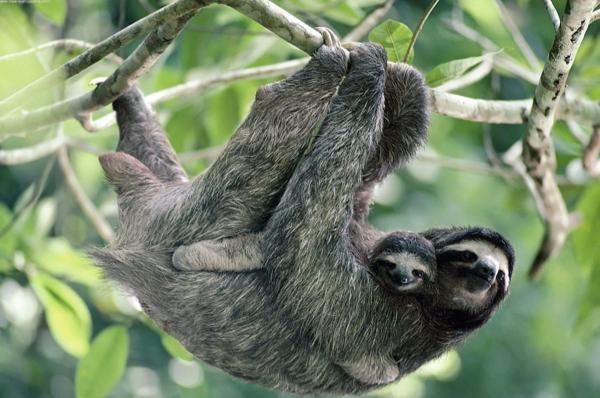
Three-toed Sloth
Source: http://www.boingboing.net/filesroot/slothfactssocute.jpg

Jaguar
Source: http://img141.imageshack.us/img141/5203/jaguarbrasilia1.jpg
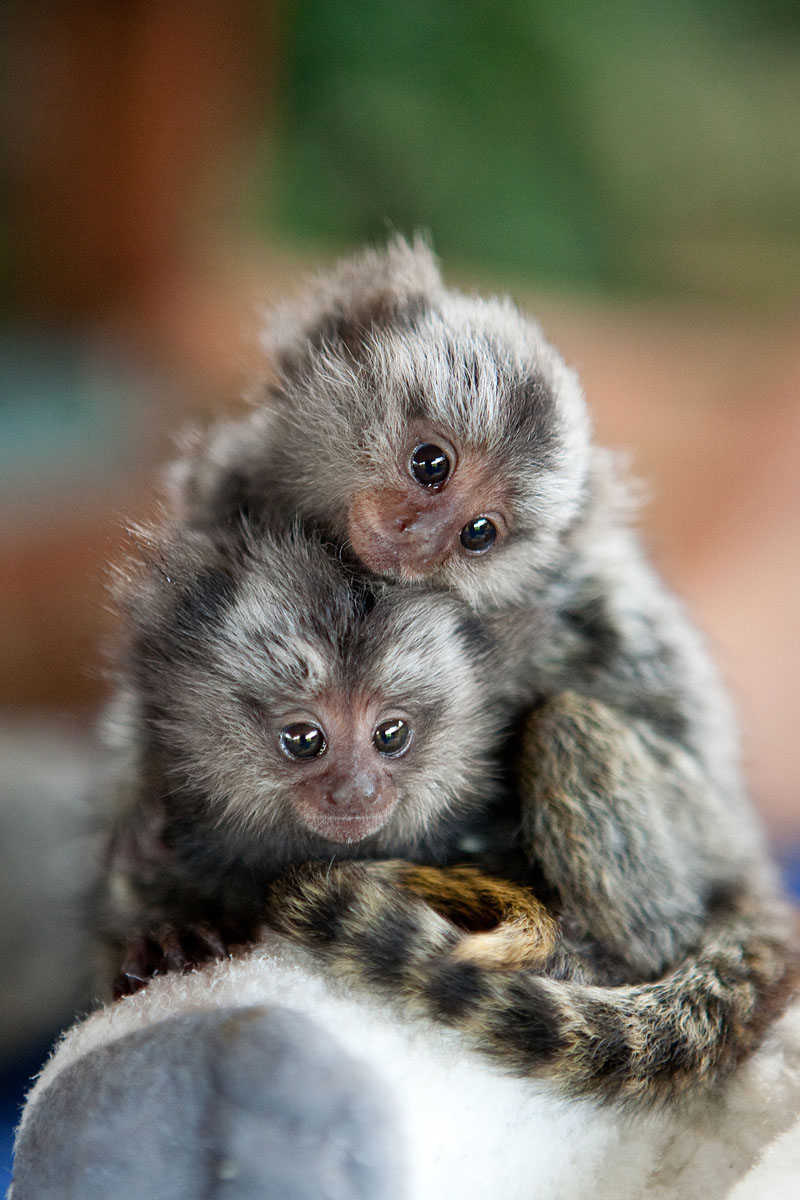
Baby Marmosets
Source: http://charlottegeary.com/wp-content/uploads/2012/05/20100803a_BlueBanyonInn_305.jpg
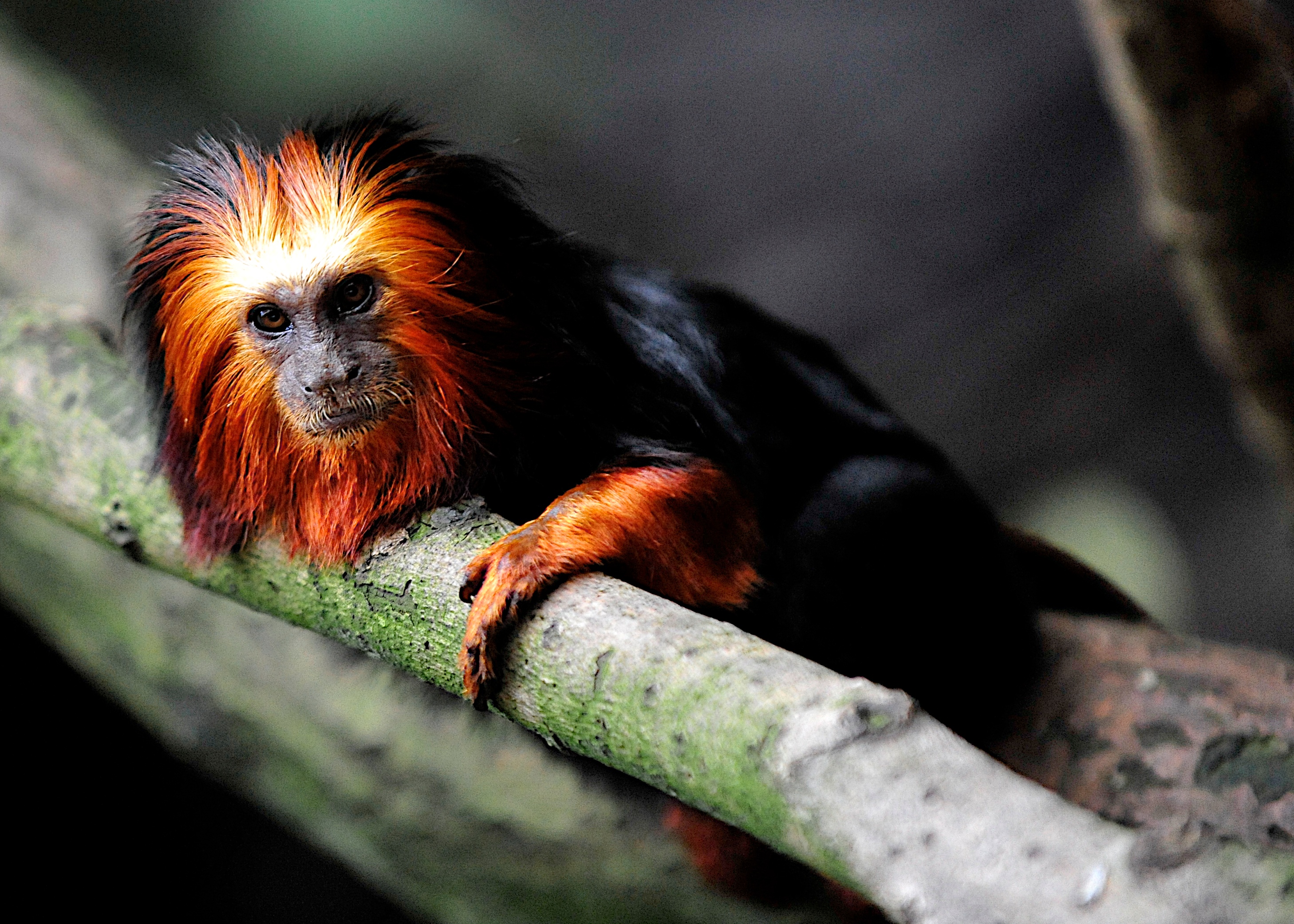
Lion Tamarin
Source: http://fc08.deviantart.net/fs70/f/2010/334/a/5/golden_lion_tamarin_ii_by_cwgk91-d33xsy3.jpg
People started to become aware that these forest were almost disappearing and there needed to be something done (7). Developing a system of National Parks was a necessary step to help protect and stop any further damage to these ecosystems.
Present:
Currently there are large blocks of tropical rainforest that still exist, but the once large and pristine forests have been seriously fragmented in recent years. The tropical evergreen forests of Costa Rica are the least well represented in their protected areas system (5). On the Pacific side, flat areas with alluvial soils are being used for cultivation of coffee and palm wine, while the less fertile hilly soil parts are being used for cattle pasture (9). On the Caribbean side, flat areas with alluvial soils are being used for banana plantations, while the less fertile hilly soil parts are also being used for cattle pasture (10).

Map of rainforest in Costa Rica throughout these dates. The green indicates where the rainforest are located and as you can see in 2005 the rainforest have started to increase again.
Source: http://treeswaterpeople.files.wordpress.com/2012/02/change-forest-cover-costa-rica.jpg

How deforestation looks like at an aerial view.
Source: http://www.foodbeautylove.com/wp-content/uploads/2012/10/Rainforest-Deforestation.jpg

Banana Plantation in Costa Rica.
Source: http://www.vagabloggers.com/wp-content/gallery/costa-rican-banana-plantation/banana-plantation1.jpg
Although there have been some negative impacts on the ecosystem by humans, I believe the conservation status is fairly good. This is largely due to the National Parks system and ecotourism that has become more popular over the years. Ecotourism has provided a high amount of income for people and the economy (11). In order to keep this vital part of the economy alive, there must be conservation of the wildlife. This helps create an incentive for the people of Costa Rica, to keep their forest protected and actually provides more capital then it did for logging, cultivation and cattle grazing (7). Costa Rica has a vast amount of national parks and wildlife reserves, which approximately cover 12.2% of the country’s territory. These protected areas give shelter for 205 species of mammals, 845 species of birds, 160 species of amphibians, 218 species of reptiles, 1013 species of fresh-water and marine fishes that have been discovered, and many species of different plants. These wild lands have become important for ecotourist, naturalist, and scientific researchers (6).
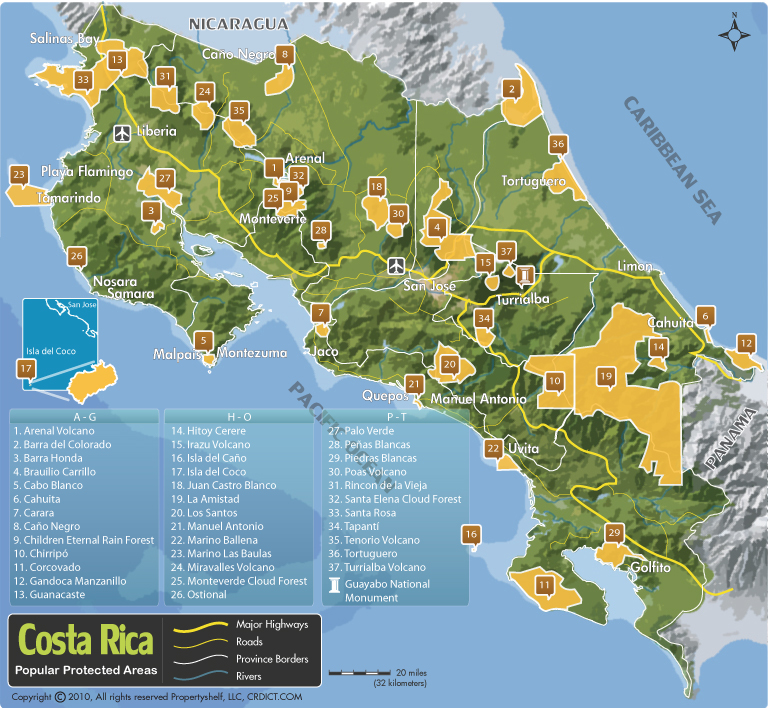
Map of National Parks in Costa Rica.
Source: http://costarica-information.com/nature/national-parks-other-protected-areas/popular-protected-areas/popular%20protected%20areas%20map

Tortuguero National Park in Costa Rica.
Source: http://explore.org/photos/2564/aerial-view-costa-rica.jpg

Monkey in Corcovado National Park in Costa Rica.
Source: https://blogger.googleusercontent.com/img/b/R29vZ2xl/AVvXsEjSE2LcUELbzWFfEpwdgzwVpmx-o-EdeYAVrj7mzCTCSOmyre1h3pHuJWVctI49HCDNETb7SopQBlhTlfnXpkAVeOaFFPfCd3oJYRJzBFi8RY0cRDgrw_qXj9nyDiaBn7KO4YUsjK09Q_c/s1600/IMG_0706.jpg

Source: http://ecolibrary.org/images/full_image/Tropical_rainforest_Costa_Rica_DP25.jpg

Source: https://blogger.googleusercontent.com/img/b/R29vZ2xl/AVvXsEh1mWmDCAIcgVACXiZCTW7Eum8hXUHhje7nrH2X3bO6zdfyPq9kyqKudPoJsTRsrVapAgRjde8-iuWn6onO1takICm32f3x4qhQz0rytpkP-s0pnHpoKni2gbMDDFxr00-mPw4Pa5v8tKs/s1600/Monteverde+Rainforest,+Costa+Rica.jpg

Source: http://farm2.staticflickr.com/1346/663194594_94efc2f9a9_o.jpg
In the early 1970s, Costa Rica was experiencing intensive deforestation for agriculture and cattle raising. This in return led to land settlements, the new construction of highways, and trade in wild animal life products (6). Deforestation caused lots of endangerment to different species in the rainforest, some which include, the Great Green Macaw, Sloths, sea turtles, jaguars, marmosets, and lion tamarins (7,8).

Great Green Macaw
Source: http://4.bp.blogspot.com/-OlLhuvUFsLA/Tr52pvKfOaI/AAAAAAAAAR4/RMjlq4MK2X0/s1600/Great+Green+Macaw+1.jpg

Three-toed Sloth
Source: http://www.boingboing.net/filesroot/slothfactssocute.jpg

Jaguar
Source: http://img141.imageshack.us/img141/5203/jaguarbrasilia1.jpg

Baby Marmosets
Source: http://charlottegeary.com/wp-content/uploads/2012/05/20100803a_BlueBanyonInn_305.jpg

Lion Tamarin
Source: http://fc08.deviantart.net/fs70/f/2010/334/a/5/golden_lion_tamarin_ii_by_cwgk91-d33xsy3.jpg
People started to become aware that these forest were almost disappearing and there needed to be something done (7). Developing a system of National Parks was a necessary step to help protect and stop any further damage to these ecosystems.
Present:
Currently there are large blocks of tropical rainforest that still exist, but the once large and pristine forests have been seriously fragmented in recent years. The tropical evergreen forests of Costa Rica are the least well represented in their protected areas system (5). On the Pacific side, flat areas with alluvial soils are being used for cultivation of coffee and palm wine, while the less fertile hilly soil parts are being used for cattle pasture (9). On the Caribbean side, flat areas with alluvial soils are being used for banana plantations, while the less fertile hilly soil parts are also being used for cattle pasture (10).

Map of rainforest in Costa Rica throughout these dates. The green indicates where the rainforest are located and as you can see in 2005 the rainforest have started to increase again.
Source: http://treeswaterpeople.files.wordpress.com/2012/02/change-forest-cover-costa-rica.jpg

How deforestation looks like at an aerial view.
Source: http://www.foodbeautylove.com/wp-content/uploads/2012/10/Rainforest-Deforestation.jpg

Banana Plantation in Costa Rica.
Source: http://www.vagabloggers.com/wp-content/gallery/costa-rican-banana-plantation/banana-plantation1.jpg
Although there have been some negative impacts on the ecosystem by humans, I believe the conservation status is fairly good. This is largely due to the National Parks system and ecotourism that has become more popular over the years. Ecotourism has provided a high amount of income for people and the economy (11). In order to keep this vital part of the economy alive, there must be conservation of the wildlife. This helps create an incentive for the people of Costa Rica, to keep their forest protected and actually provides more capital then it did for logging, cultivation and cattle grazing (7). Costa Rica has a vast amount of national parks and wildlife reserves, which approximately cover 12.2% of the country’s territory. These protected areas give shelter for 205 species of mammals, 845 species of birds, 160 species of amphibians, 218 species of reptiles, 1013 species of fresh-water and marine fishes that have been discovered, and many species of different plants. These wild lands have become important for ecotourist, naturalist, and scientific researchers (6).
Map of National Parks in Costa Rica.
Source: http://costarica-information.com/nature/national-parks-other-protected-areas/popular-protected-areas/popular%20protected%20areas%20map

Tortuguero National Park in Costa Rica.
Source: http://explore.org/photos/2564/aerial-view-costa-rica.jpg

Monkey in Corcovado National Park in Costa Rica.
Source: https://blogger.googleusercontent.com/img/b/R29vZ2xl/AVvXsEjSE2LcUELbzWFfEpwdgzwVpmx-o-EdeYAVrj7mzCTCSOmyre1h3pHuJWVctI49HCDNETb7SopQBlhTlfnXpkAVeOaFFPfCd3oJYRJzBFi8RY0cRDgrw_qXj9nyDiaBn7KO4YUsjK09Q_c/s1600/IMG_0706.jpg
Future:
Based on current conservation methods, Costa Rica will continue to help save and protect more forests. Costa Rica has become a staple and leader of what other countries with rainforest should do. As more people become more educated and ecotourism becomes even more popular, it will create even more protected forests.
In order to maintain and improve impacts on this ecosystem, we need to continue to educate the population about the rainforest, the negative impacts and the positive impacts as well. The government needs to expand the national park system and implement more laws against deforestation and other impacts, as well as regulate illegal activity. Plants and trees need to be planted in forests that have been destroyed for cultivation or cattle grazing. This will help expand these forests and bring back species that are being threatened due to the loss of their habitats.
Thoughts:
The tropical rainforest of Costa Rica benefit us in many ways. Tropical rainforest are home to a high amount of plants that produce photosynthesis that help fixate great amounts of carbon dioxide from the atmosphere and release great amounts of oxygen back into the atmosphere (2). This helps reduce global warming and provides us with oxygen for us to breath. There are also very high amounts of species richness and with research some of the species may be able to help us find cures to diseases and sicknesses. Rainforests and their biodiversity also provide us with beauty for us to enjoy.
The benefits that the tropical rainforest provides us with, is one of the major reasons why we need to continue to protect and save these rainforests. Giving more people awareness about the beauty and benefits of this ecosystem can help us save and protect this magnificent ecosystem and what we call “planet earth.”
Thoughts:
The tropical rainforest of Costa Rica benefit us in many ways. Tropical rainforest are home to a high amount of plants that produce photosynthesis that help fixate great amounts of carbon dioxide from the atmosphere and release great amounts of oxygen back into the atmosphere (2). This helps reduce global warming and provides us with oxygen for us to breath. There are also very high amounts of species richness and with research some of the species may be able to help us find cures to diseases and sicknesses. Rainforests and their biodiversity also provide us with beauty for us to enjoy.
The benefits that the tropical rainforest provides us with, is one of the major reasons why we need to continue to protect and save these rainforests. Giving more people awareness about the beauty and benefits of this ecosystem can help us save and protect this magnificent ecosystem and what we call “planet earth.”
Resources:
- World Wildlife Fund (Lead Author);C Michael Hogan (Topic Editor) "Ecoregions of Costa Rica". In: Encyclopedia of Earth. Eds. Cutler J. Cleveland (Washington, D.C.: Environmental Information Coalition, National Council for Science and the Environment). [First published in the Encyclopedia of Earth August 26, 2012; Last revised Date August 26, 2012; Retrieved November 30, 2012 <http://www.eoearth.org/article/Ecoregions_of_Costa_Rica>.
- "Costa Rica Tropical Rainforest." Tropical Rainforest: Costa Rica Rainforest Animals & Plants Biome. Costa Rica 21, 2 Apr. 2012. Web. 02 Dec. 2012. <http://www.costarica21.com/Tropical-Rainforest.html>.
- Baker, Christopher P. "Flora of Costa Rica." Flora of Costa Rica. N.p., n.d. Web. 02 Dec. 2012. <http://www.centralamerica.com/cr/moon/moflora.htm>.
- "Costa Rica History." History of Costa Rica. Lonely Planet, n.d. Web. 02 Dec. 2012. <http://www.lonelyplanet.com/costa-rica/history>.
- Powell, George, Sue Palminteri, and Jan Schipper. "Central America: Southern Costa Rica to the Southwest Coast of Panama." Wildlife Conservation, Endangered Species Conservation. World Wild Life, n.d. Web. 02 Dec. 2012. <http://worldwildlife.org/ecoregions/nt0130>.
- Boza, Mario A. "Conservation in Action: Past, Present, and Future of the National Park System of Costa Rica*." Conservation Biology 7.2 (2002): 239-247.
- "Tropical Rainforest at La Leona." Costa Rica Rain Forest. La Leona Ecolodge, 2009. Web. 02 Dec. 2012. <http://www.laleonaecolodge.com/costa-rica-rain-forest.html>.
- Willis, Devon. "Animals That Live in the Central American Atlantic Rainforest." EHow. Demand Media, 26 May 2011. Web. 02 Dec. 2012. <http://www.ehow.com/info_8495573_animals-central-american-atlantic-rainforest.html>.
- World Wildlife Fund, C Michael Hogan (Lead Author);Mark McGinley, Peter Saundry (Topic Editor) "Isthmian-Pacific moist forests". In: Encyclopedia of Earth. Eds. Cutler J. Cleveland (Washington, D.C.: Environmental Information Coalition, National Council for Science and the Environment). [First published in the Encyclopedia of Earth January 23, 2010; Last revised Date August 28, 2012; Retrieved December 2, 2012 <http://www.eoearth.org/article/Isthmian-Pacific_moist_forests?topic=49597>
- World Wildlife Fund (Lead Author);C Michael Hogan (Contributing Author);Mark McGinley (Topic Editor) "Isthmian-Atlantic moist forests". In: Encyclopedia of Earth. Eds. Cutler J. Cleveland (Washington, D.C.: Environmental Information Coalition, National Council for Science and the Environment). [First published in the Encyclopedia of Earth January 24, 2010; Last revised Date October 11, 2011; Retrieved December 2, 2012 <http://www.eoearth.org/article/Isthmian-Atlantic_moist_forests?topic=49597>
- Jacobson, Susan K., and Rafael Robles. "Ecotourism, sustainable development, and conservation education: Development of a tour guide training program in Tortuguero, Costa Rica." Environmental Management 16.6 (1992): 701-713.
This comment has been removed by the author.
ReplyDeleteThis has been a remarkably helpful resource for research I am doing. Though the jungles are so well-known, it is actually difficult to find concrete information on them that isn't vague and dazzling with the motive of getting you to book a vacation. Thanks!
ReplyDelete